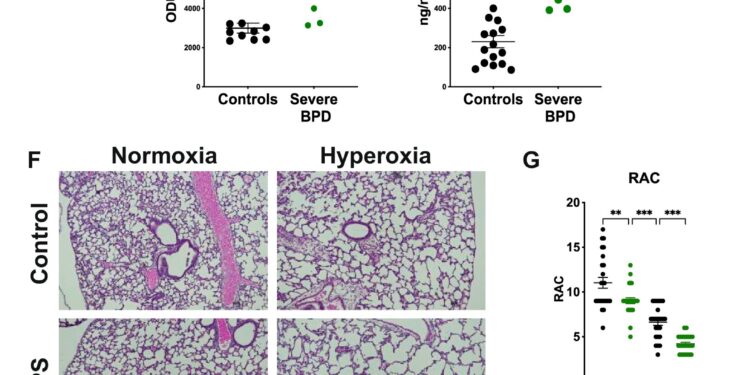Severe BPD is characterized by decreased Lactobacilli, increased Proteobacteria, and neutrophil influx mediated by the MMP-9/Ac-PGP pathway. Credit: Nature Communications (2024). DOI: 10.1038/s41467-024-51169-0
In recent preclinical models, inhalation of a mixture of live Lactobacilli bacteria attenuated lung inflammation and improved lung function and structure in bronchopulmonary dysplasia and chronic obstructive pulmonary disease (COPD), two chronic lung diseases.
This study, published in the journal Nature Communicationsdetermined the mechanism of this live biotherapeutic product – a powdered blend of live Lactobacilli bacteria – to reduce neutrophilic inflammation and reduce a broad range of inflammatory markers in BPD and COPD, says Charitharth Vivek Lal, MD, a neonatologist at the University of Alabama at Birmingham who co-led the research with Amit Gaggar, MD, PhD, a UAB pulmonologist.
Their findings “provide a paradigm for the progression of structural lung disease,” Lal said, because they identify Lactobacilli as critical in regulating pulmonary protease activity that is linked to destruction caused by matrikine generation, extracellular matrix turnover and chronic neutrophil inflammation that damages air sacs in the lungs.
A possible protective role for lactobacilli in the lungs and the possible use of lactobacilli to treat chronic lung disease was discovered in 2016 when Lal and colleagues at UAB found that the airways of infants with severe bronchopulmonary dysplasia had reduced numbers of lactobacilli, increased numbers of proteobacteria, and increased concentrations of proteobacterial endotoxins.
In this latest study, UAB researchers provide a mechanism of action for lactobacilli treatment to decrease downstream disease development and demonstrated the safety and efficacy of the live biotherapeutic treatment in a mouse pup model of BPD and three mouse models of COPD.
Bronchopulmonary dysplasia develops in some extremely premature infants after injury from high oxygen tension or mechanical ventilation needed to keep them alive. COPD occurs in older people, especially smokers, and kills about 130,000 Americans each year and about 3 million more worldwide.
“Inhaled live biotherapeutics show promise in addressing common pathways of disease progression and, in the future, may be targeted against a variety of lung diseases,” Lal said. “Preclinical animal data are suggestive and the safety of the potential drug in humans will be tested in an upcoming clinical trial. The adult safety data in COPD will help de-risk the approval process for use in infants with bronchopulmonary diseases.”
The UAB researchers hypothesized that mouse models of borderline personality disorder would show increased levels of acetylated proline-glycine-proline, or Ac-PGP, a peptide derived from the extracellular matrix, as had been observed in premature infants with borderline personality disorder.
This has been demonstrated in mouse models of borderline personality disorder, and gain- or loss-of-function studies have shown the impact of Ac-PGP. Intranasal instillation of Ac-PGP increased neutrophilic inflammation and lung damage. When an Ac-PGP inhibitor was administered with Ac-PGP, markers of neutrophilic inflammation decreased and lung structure improved.
The researchers then showed that a proprietary blend of Lactobacilli from L. planatarum, L. acidophilus, and L. rhamnosus was most synergistically effective in reducing the inflammatory proteinase MMP-9, which helps release Ac-PGP from the extracellular matrix. Additionally, the supernatant from the Lactobacilli growth medium also reduced MMP-9 to a similar extent as live Lactobacilli bacteria.
One of the main findings was that L(+) lactic acid, produced in the supernatant of the growth medium of lactobacilli, reduced MMP-9 in vitro, which shows the important role of this lactic acid as an anti-inflammatory molecule. The researchers found that lactobacilli living in the lungs ensured a continuous and sustained release of L(+) lactic acid in a controlled and well-tolerated manner.
One of the major technological advances reported in the study was the creation of particle-engineered inhaled lactobacilli powder – particles small enough to reach the lungs while preserving viable bacteria. This live biotherapeutic was then tested in models of borderline personality disorder and COPD. In mouse models of COPD, the mixture successfully reduced inflammation in the lung microenvironment – whether treated concurrently or after injury – showing anti-inflammatory effects, a decrease in several pro-inflammatory markers, and an elevation of the anti-inflammatory marker IgA.
An interesting finding was the favorable efficacy of the live biotherapeutic. It reduced MMP-9 and other pro-inflammatory cytokines as well as—or in some cases better than—fluticasone furoate, an inhaled corticosteroid approved by the U.S. Food and Drug Administration and used in combination therapies for COPD.
Safety and biodistribution studies in one of the mouse models of COPD showed that inhalation of the bacterial powder did not result in adverse reactions or disease, and that lactobacilli did not move to distal tissues or accumulate in the lungs.
The study’s co-senior authors are Teodora Nicola and Nancy Wenger, of the UAB Department of Pediatrics, Division of Neonatology. Other authors, along with Lal, Gaggar, Nicola and Wenger, are Xin Xu, Camilla Margaroli, Kristopher Genschmer, J. Edwin Blalock, of the UAB Department of Medicine, Division of Pulmonology, Allergy and Critical Care; and Michael Evans, Luhua Qiao, Gabriel Rezonzew, Youfeng Yang, Tamas Jilling, Kent Willis and Namasivayam Ambalavanan, of the UAB Department of Pediatrics, Division of Neonatology.
More information:
Teodora Nicola et al, A live inhaled lactobacilli biotherapeutic attenuates pulmonary neutrophilic inflammation, Nature Communications (2024). DOI: 10.1038/s41467-024-51169-0
Provided by the University of Alabama at Birmingham
Quote:Inhalation of live lactobacilli reduces lung inflammation and improves lung function, preclinical study finds (2024, August 21) retrieved August 21, 2024 from
This document is subject to copyright. Apart from any fair dealing for the purpose of private study or research, no part may be reproduced without written permission. The content is provided for informational purposes only.



